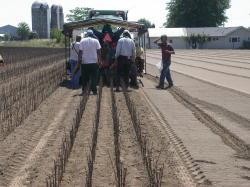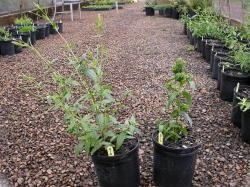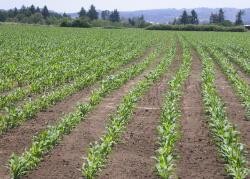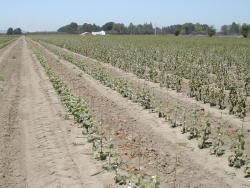- But don’t leave them for more than a day or two, or you’ll have purple, moldy peaches.
C. Jar method - For a few tomatoes
- Assemble the jars and remove the lids.
- Put in one ripening banana per jar.
- Put in two to four medium-sized green tomatoes per jar. Do not overfill the jar, or the tomatoes might bruise.
- Screw on lid tightly.
- Leave in a warm, semi-humid place, out of direct sunlight. Check regularly - if your banana starts to rot before the tomatoes are ready, remove it and replace with a new banana. This method should leave you with ripened tomatoes within one - two weeks.
Further reading 4
HERBICIDE RESIDUES IN FIELD SOILS
I. Introduction
|
Figure 1. The primary concern with herbicide carryover is that herbicides applied this year will negatively affect small plants lined out next year. |
Có thể bạn quan tâm!
-
 Giáo trình Anh văn chuyên ngành Nghề Khoa học cây trồng - Cao đẳng - Trường Cao đẳng Cộng đồng Đồng Tháp - 6
Giáo trình Anh văn chuyên ngành Nghề Khoa học cây trồng - Cao đẳng - Trường Cao đẳng Cộng đồng Đồng Tháp - 6 -
 Transplanting Method Helping Increase Paddy Yields
Transplanting Method Helping Increase Paddy Yields -
 Giáo trình Anh văn chuyên ngành Nghề Khoa học cây trồng - Cao đẳng - Trường Cao đẳng Cộng đồng Đồng Tháp - 8
Giáo trình Anh văn chuyên ngành Nghề Khoa học cây trồng - Cao đẳng - Trường Cao đẳng Cộng đồng Đồng Tháp - 8 -
 Giáo trình Anh văn chuyên ngành Nghề Khoa học cây trồng - Cao đẳng - Trường Cao đẳng Cộng đồng Đồng Tháp - 10
Giáo trình Anh văn chuyên ngành Nghề Khoa học cây trồng - Cao đẳng - Trường Cao đẳng Cộng đồng Đồng Tháp - 10 -
 Giáo trình Anh văn chuyên ngành Nghề Khoa học cây trồng - Cao đẳng - Trường Cao đẳng Cộng đồng Đồng Tháp - 11
Giáo trình Anh văn chuyên ngành Nghề Khoa học cây trồng - Cao đẳng - Trường Cao đẳng Cộng đồng Đồng Tháp - 11
Xem toàn bộ 91 trang tài liệu này.
Herbicides applied this year may carry over and injure small plants lined out the following year. This article will address how herbicides degrade in the environment, how to predict the length of time herbicides persist, and management practices that can be used to mitigate herbicide carryover.
Preemergence herbicides can be a double-
edged sword. We want them to persist for several months in order to suppress weeds. Yet, we don’t want them to persist too long so that they interfere or injure crops planted
the following year. Arnold Appleby, a long time OSU weed scientist once said jokingly, “Ideally, we would like the herbicides to last for the crop season, then self-destruct instantly.” Clearly that’s not going to happen, and small amounts of some herbicides can injure sensitive crops. Smaller plants are more sensitive than larger ones, and plants grown from seed are most sensitive.
Because herbicide carryover is primarily an issue with agronomic crops grown from seed, many herbicide labels provide a plant back restriction. This is the time period that must pass before planting a specific crop after herbicide application. Plant back restrictions vary for each unique combination of herbicide and crop. For example, spinach and sugar beets cannot be planted for 24 months after an applications of halosulfuron (Permit or Manage). However, there is little or no work to establish when nursery crops should be planted after herbicide applications. Due to the vast number of species grown in the nursery industry, the
span of sizes lined out in fields, the plant source (tissue culture, rooted cutting, seedling, etc.), and the limited acreage of land planted with nursery crops, it’s not likely that the herbicide manufacturers will ever develop this type of information for ornamental labels. So it is up to nursery managers to be aware of potential pitfalls with herbicide carryover and manage their weed control programs to avoid these problems.
II. Herbicide half-life
|
Figure 2. The weed to the right was exposed to sublethal herbicide concentrations, and is displaying typical signs of stunting and distortion. |
How long will a herbicide persist in the environment? That depends on a lot of factors, but there is a gauge by which we can predict herbicide persistence. Herbicide half-life is a measure of how long it takes for 50% of a chemical to degrade. For example, oxadiazon has a half-life of 60 days. So 60 days after application, it will have degraded to ½ of the amount applied. After 120 days,
the concentration will have decreased by
50% again so that only ¼ of the applied amount remains. Assuming a 240 day
growing season with conditions optimum for herbicide breakdown, only 1/16 of the applied product will remain at the end of the season.
Herbicide half life values are derived from many sources. These values were determined using various methods, under different environmental conditions, in different parts of the world. Comparing one herbicide to another is almost like comparing apples to oranges, but it is the best gauge we have right now. Use half- lives as a guide in selecting herbicides, not as absolute values for predicting herbicide degradation.
III. How herbicides degrade
Herbicides degrade over time. How long a herbicide persists is dependent on several factors including light, temperature, and soil moisture. Herbicides dissipate via several pathways including: photodegradation, chemical degradation, microbial degradation, leaching, and volatilization. Photodegradation occurs when ultraviolet (UV) light breaks chemical bonds of the herbicide’s active ingredient. Secondary molecules resulting from the cleavage of the parent molecule are generally less effective in providing weed control.
Microbial degradation occurs when soil microorganisms use the herbicides as a food source. Virtually all pesticides are organic compounds comprised mostly of carbon, hydrogen, nitrogen, and sulfur. These compounds are a food source for microorganisms. When the same chemical is applied repeatedly, microorganisms that preferentially feed on the chemical increase in number, consuming the chemical and thus reducing its efficacy and longevity of control. This is particularly important with preemergence herbicides which are designed to have longevity in soil.
Chemical degradation occurs when a non-biological chemical reaction cleaves the herbicide active ingredient into non-active secondary molecules. The most common form of chemical degradation is hydrolysis.
Leaching of preemergence herbicides is minimal. Products used in nursery production have low solubility and are adsorbed tightly to soil particles. Applying irrigation to maintain adequate soil moisture will accelerate biological activity and thus accelerate herbicide degradation. However, using irrigation to ‘leach’ herbicides from soil will not work, and is a waste of water and time.
Volatilization is the process by which chemicals go from a solid or liquid state into a gaseous state. When herbicides volatilize to a gas and release into the atmosphere, they no longer provide weed control. Of preemergence herbicides labeled for nursery crops, trifluralin is most subject to volatilization.
IV. Management practices to prevent carryover
|
Figure 3. Planting fields with a cover crop for one growing season before replanting trees will greatly reduce herbicide residues. |
Many nursery crops require 2 or 3 years in the field. If herbicides applied the first year persist through to the second year, that’s not such a bad thing. What is of concern are herbicides applied the last year a crop is in the field, and whether or not they persist until the time the next crop is lined out.
There are several factors that accelerate or
slow down the degradation process. Low pH, high soil temperature, high soil moisture, high microbial or biological
activity, and high levels of organic matter accelerate herbicide degradation.
An effective way to ensure herbicides don’t carryover is to plant the field to cover crop for one growing season. For example, if trees are dug this November, rotate that field out of production and plant a cover crop the following summer. Next fall, turn the cover crop under and replant the field, or prepare for a spring planting in 2005.
Planting cover crops increases soil organic matter and biological activity. These two factors promote herbicide degradation. In growing the cover crop, use irrigation and fertilizers, but don’t use additional herbicides. High nitrogen levels and soil moisture increases soil biological activity and further accelerates herbicide degradation.
Planting a field to cover crop instead of money-making nursery crops may seem like a huge sacrifice just to avoid the possibility of herbicide carryover. However, cover cropping does more than just degrade herbicides. Using a cover crop rebuilds soil structure, adds organic matter back to the field, increases soil aggregates, relieves soil compaction, and improves water percolation. Constant nursery production can reduce field productivity over time. Using cover crops can reverse some of the negative effects of constant farming.
|
Figure 4. Use any labeled herbicide during the first year of production, but use products with shorter half-lives during the year of harvest. |
V. Plan ahead
Planning which herbicides to use can also prevent problems with herbicide carryover. Use any labeled herbicide prior to the year of harvest. Consider applying herbicides with short half-lives during the year of harvest. This will decrease the probability of carryover when fields are replanted.
Consider the following example in selecting herbicides to avoid problems with carryover. The first step to selecting a herbicide is to be sure it is labeled for the intended use. Assuming label restrictions
are met, isoxaben and oryzalin might be used during the first year of production. Despite their long half-lives, there is broad spectrum crop tolerance to these products, and carryover is not a major concern during the first year of production. In the spring of the year preceding harvest (2nd or 3rd year of production), oxyfluorfen and pendimethalin could be used because of their shorter half-lives. More established plants are generally more tolerant of these two herbicides. Planning herbicide applications can further reduce the probability that herbicide carryover will injure the next crop.
VI. Conducting a bioassay
A quick and easy way to determine if soil is contaminated is to conduct a bioassay. In general, a bioassay is any test that uses a living organism to test for activity of a substance. For our purposes, we are going to use the seed of herbicide-sensitive plants to test for herbicide activity. This can be done during the winter in a warm greenhouse.
VII. Conclusions
Herbicide carryover is probably not a widespread problem in nursery production, primarily because we are lining out relatively large plants (compared
to farmers who sow seed). However, some nurserymen have observed stunted and/or poor growth in certain crops, and have attributed this in part to herbicide carryover. Some species can be sensitive to some herbicides, so plan ahead, schedule the right herbicides to avoid carryover, and if possible use cover crops in your planting rotations.
James Altland, Ph.D. North Willamette Research and Extension Center (NWREC)
Oregon State University
Further reading 5
COMMON HOUSEPLANT INSECTS AND RELATED PESTS
When a houseplant looks less than healthy, most often it is the result of improper care. Factors such as too much or too little water, light, heat or fertilizer can cause many plant problems. However, in some cases the problem results from a pest infestation. Several insects and other pests feed on houseplants. These pests most often come into the home on newly purchased plants or on those that have been outside for the summer.
I. Prevention
The best way to control insects and related pests on houseplants is through prevention, as it is almost always easier to prevent a pest infestation than to eliminate one. There are several precautions that you can take which will decrease the chances of having to deal with a pest infestation of your houseplants.
Provide a plant with the growing conditions that it needs so that it is more likely to grow vigorously. Stressed plants tend to be more susceptible to pests.
Before buying or bringing a plant indoors, always check it and its container for signs of pests.
A plant that has been outside for the summer, especially one sitting on the ground, may have pests that have crawled in through the drainage holes. Take the plant out of the pot to examine the soil.
Isolate new plants from plants already in the home for six weeks to ensure that any pest brought in will be less likely to spread.
While plants are isolated, carefully examine them for signs of pests or damage on a regular basis of about once a week. Pay particular attention to the undersides of leaves where pests are most often found. Using a 10X magnifying lens will make it easier to see small pests and also immature pest stages. Infestations are often much easier to control if caught early.
When repotting a plant, use commercially prepared potting soil rather than soil from outdoors, which can be a source of pests.
Washing smooth-leaved plants every two to three weeks discourages pest infestations and also improves the appearance of foliage. Small plants can









